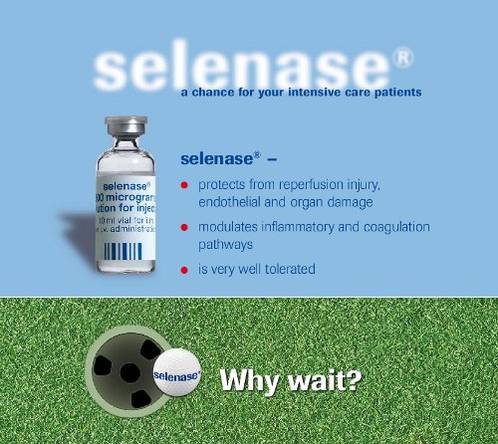Selenase® In Intensive Care
Protection Against Reperfusion Injury
- Sepsis
- Myocardial infarction
- Ischaemic stroke
- Transplantation
- Vascular surgery
- Plastic/reconstructive surgery
- Hypovolaemic shock, resuscitation
Tissue Damage Due to Ischaemia/Reperfusion
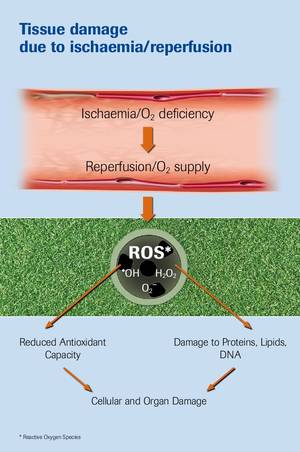
Selenium Status Correlates With The Extent of Damage
Altekin et al. 2005
Study in 70 patients with myocardial infarction

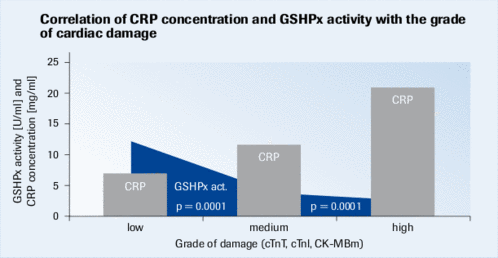
Grade of damage
| cTnT [ng/ml] | cTnI [ng/ml] | CK-MBm [ng/ml] | |
| low (n=29) | 0.1-0.3 | 0.2-0.5 | 7.0-10.0 |
|---|---|---|---|
| medium (n=14) | 0.4-0.8 | 0.6-1.0 | 10.0-30.0 |
| high (n=27) | > 0.9 | > 1.0 | > 30 |
High Selenite Doses Protect Against Ischaemia / Reperfusion Damage
Venardos et al. 2004:
Study in the isolated rat heart (pre-treatment for 5 weeks)

Ischaemic contraction at the end of the ischaemic phase is a measure for the severity of ischaemic damage.
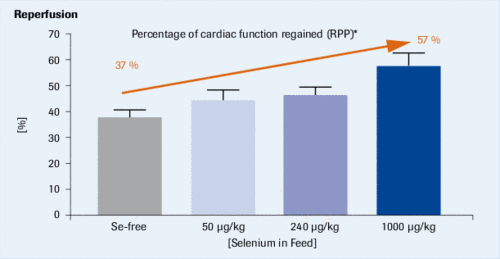
Percentage of cardiac function regained after ischaemic and reperfusion phases.
∗RPP (Rate Pressure Product) = Product of heart rate and blood pressure
Selenase® Protects From ROS
- Initially
- During ischaemia
- During reperfusion
Less damage to
- blood vessels
- tissues
- organs
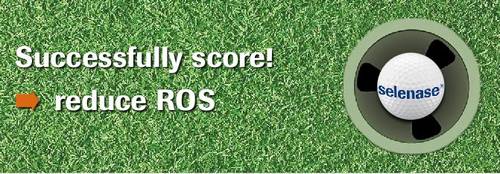
Dosage recommendation∗:
1000 µg selenium/day, until normal levels have been restored (cf. SIC Study (3): 2000 µg day 1; 1000 µg/day day 2 14)
∗Further information on dosage and application see national SPC.
1 µmol Se = 78.96 µg Se
Action of Selenite Supplementation In Ischaemia/Reperfusion
For example:
Clinical Chemistry
- Maintenance of antioxidant capacity (GSH/GSSG-ratio)
- Increase of expression and activity of ROS degrading selenoenzymes (glutathione peroxidases, thioredoxin reductases)
- Reduction of
- Inflammatory markers (e.g. CRP)
- Ischaemic markers in myocardial infarction (e.g. troponins, CK-MB)
- Oxidative markers (e.g. malondialdehyde)
- Redox signals (e.g. NF-kB activation)
Animal Experiments
- Reduction of the extent of tissue damage
- Improvement of post-ischaemic mean arterial blood pressure (in myocardial I/R)
- Reduction of oedema (in cerebral I/R)
| Selenium effect in general | Selenium effect in detail | Selenium level/dose |
|---|---|---|
| SEPSIS | ||
| Selenium supplementation reduces mortality in sepsis patients (3, 15) | Sepsis patients: increase of glutathione peroxidase activity; reduction of MDA, NF-kB activity, IL-6, acute renal failure | Up to 1000 μg/day (2000 μg on day 1 only) up to 14 days i.v. as sodium selenite. Med Klin 1997, Crit Care Med 2007 |
| MYOCARDIAL INFARCTION | ||
| Selenium supplementation increases ischaemic tolerance in neonatal hearts (7) | In hearts of immature rat foetuses: increase of ischaemic tolerance, reduction of lipofuscin pigments and serum NO concentration | Oral pre-treatment of pregnant rats: 2000 μg/kg drinking water vs. 237 μg/kg feed Chin Med J 2000 |
| Selenium levels correlate with the extent of myocardial damage (2) | In 70 patients with myocardial infarction: low selenium levels correlate with: inflammatory markers: CRP↑, prognosis markers: CK-MB↑, cardiac troponins↑ | 107 μg/l vs. 68 μg/l (median) (= 1.36 μmol/l vs. 0.86 μmol/l) J Trace Elem Med Biol 2005 |
| Selenium supplementation increases antioxidant capacity and reduces cardiac damage (12) | In isolated rat hearts:dose dependent im provement of heart function, less reduction of GSH (vs. GSSG), reduction of increase in MDA as well as reduction of increased NF-kB values, reduced cardiac damage due to xanthine oxidase, •OH or Ca2+. | Selenium administration 10 min. before ischaemia and during 30 min. of reperfusion. Up to 78.7 μg/l selenium in perfusion medium. Antioxid Redox Signal 2005 |
| Pre-ischaemic selenium status is the deciding factor for outcome (9) | In Wistar rats:high dose selenium diet: reduced extent of infarction, maintains postischaemic GSH/GSSG ratio; increases GPx activity; improves postischaemic average arterial blood pressure | 1500 μg vs 50 μg Se/kg feed during 10 weeks Antioxid Redox Signal 2004 |
| Sufficiently high doses of selenium increase tolerance of ischaemia and reperfusion (13) | In isolated rat hearts:increase of expression of thioredoxin reductases (Txrd-1, Txrd-2) and glutathione peroxidases (GPx-1, GPx-2), increase of I/R tolerance | Oral pre-treatment over 5 weeks: 1000 μg/kg vs. 240 μg/kg [sodium selenite/feed] Mol Cell Biochem 2005 |
| Selenium supplementation before I/R increases the antioxidant capacity of the myocardium | In 23/23 patients with acleistocardia or a defect of the interventricular septum:no significant increase of Se blood levels but higher myocardial Se concentration and GPx-mRNA expression and activity, as well as lower MDA concentration | 400 μg selenium over 7 days pre heart surgery Zhonghua Y; Xul Za Zhi 1999 Chin Med J 2000 |
| CEREBRAL STROKE | ||
| Sufficiently high selenium doses protect against cerebral cell death due to Ischaemia/ Reperfusion (14) | In Wistar rats:positive effect on: ATP levels, intracellular Ca2+, heat shock protein 70, caspase-3 activity; less oedema and cell separation with minimal microglial cell infiltration. | i.p. pre-treatment over 7 days: up to 100 μg/kg body weight as sodium selenite Brain Res 2007 |
| Se-supplementation protects against neurodegeneration in cerebral ischaemia (4) | In rats:protection against neuronal lipidperoxidation | Pre-treatment over 7 days up to 200 μg/kg body weight as sodium selenite Biol Trace Elem Res 2004 |
| VASCULAR SURGERY | ||
| Selenite as a possible therapy to reduce peroxynitrite formation from NO in vascular surgery (1) | Theoretical observations on data of 40 patients with aortic aneurysm and peripheral arterial occlusive disease. | Med Klin 1997 |
| ORGAN TRANSPLANTATION | ||
| Selenite supplementation of the perfusion solution protects transplanted kidneys against oxidative damage (11) | Animal model: Non-heart-beating donor: malondialdehyde concentration in venous blood of donor kidneys is significantly reduced | Selenium supplementation over 120 minutes after organ donation Transplant Proc 2003 |
Literature on Reactive Oxygen Species in Intensive Care Medicine
A redox imbalance occurs during sepsis. Supplementation of antioxidant vitamins and enzymes can maintain the redox balance.
Bayir H: Reactive oxygen species. Crit Care Med 2005 Vol 33, No.12 (Suppl.)
Literature
- Albrecht S, Zimmermann T, Ockert D, Oelschläger S, Heinzmann J, Schilling JU. Verhindert Selen die Peroxinitritbildung aus NO bei gefäßchirurgischen Eingriffen? Med Klin (Munich). 1997 Sep 15;92 Suppl 3:10-1.
- Altekin E, Coker C, Sisman AR, Onvural B, Kuralay F, Kirimli O: The relationship between trace elements and cardiac markers in acute coronary syndromes. J Trace Elem Med Biol. 2005;18(3):235-42.
- Angstwurm MWA, Engelmann L, Zimmermann T, Lehmann C, Spes CH, Abel P, Strauß R, Meier-Hellmann A, Insel R, Radke J, Schüttler J, Gärtner R: Selenium in intensive care (SIC) study: Results of a prospective randomized, placebo-controlled, multiple-center study in patients with severe systemic inflammatory response syndrome, sepsis, and septic shock. Crit Care Med 35 (2007) 1-9.
- Ansari MA, Ahmad AS, Ahmad M, Salim S, Yousuf S, Ishrat T, Islam F: Selenium protects cerebral ischemia in rat brain mitochondria. Biol Trace Elem Res. 2004 Oct;101(1):73-86.
- Huang Y, Bai H, Zhang Z: Mechanism of selenium protecting against free radical damages during myocardial ischemia/reperfusion in rats. Zhonghua Yi Xue Za Zhi. 1999b Nov;79(11):852-6.
- Huang Y, Liu Y, Zhang Z: Mechanism of selenium defending against free radical damages during myocardial ischemia/reperfusion in human. Zhonghua Yi Xue Za Zhi. 1999a Oct;79(10):731-4.
- Liu D, Liu S, Huang Y, Liu Y, Zhang Z, Han L: Effect of selenium on human myocardial glutathione peroxidase gene expression. Chin Med J (Engl). 2000 Sep;113(9):771-5.
- Ostadalova I, Vobecky M, Chvojkova Z, Mikova D, Hampl V, Wilhelm J, Ostadal B: Selenium protects the immature rat heart against ischemia/reperfusion injury. Mol Cell Biochem. 2007 Jun;300(1-2):259-67. Epub 2006 Dec 23.
- Tanguy S, Morel S, Berthonneche C, Toufektsian MC, de Lorgeril M, Ducros V, Tosaki A, de Leiris J, Boucher F: Preischemic selenium status as a major determinant of myocardial infarct size in vivo in rats. Antioxid Redox Signal. 2004 Aug;6(4):792-6.
- Treska V, Kuntscher V, Molácek J, Kobr J, Racek J, Trefil L: Can ischemia-reperfusion syndrome in transplanted kidneys procured from non-heart-beating donors be influenced by adding selenium into the reperfusion solution? An experimental study. Transplant Proc. 2003 Dec;35(8):3125-7.
- Treska V, Kuntscher V, Molácek J, Kobr J, Racek J, Trefil L: Can ischemiareperfusion syndrome in transplanted kidneys procured from non-heart-beating donors be influenced by adding selenium into the reperfusion solution? An experimental study. Transplant Proc. 2003 Jun;35(4):1584-6.
- Turan B, Saini HK, Zhang M, Prajapati D, Elimban V, Dhalla NS: Selenium improves cardiac function by attenuating the activation of NF-kappaB due to ischemia-reperfusion injury. Antioxid Redox Signal. 2005 Sep-Oct;7(9-10):1388-97.
- Venardos K, Harrison G, Headrick J, Perkins A: Effects of dietary selenim on glutathione peroxidase and thioredoxin reductase activity and recovery from cardiac ischemia-reperfusion. J of Trace Elem in Med and Bio 18 (2004) 81-88.
- Yousuf S, Atif F, Ahmad M, Hoda MN, Khan MB, Ishrat T, Islam F: Selenium plays a modulatory role against cerebral ischemia-induced neuronal damage in rat hippocampus. Brain Res. 2007 May 25;1147:218-25. Epub 2007 Feb 17.
- Zimmermann T, Albrecht S, Kühne H Vogelsang U, Grützmann R, Kopprasch S: Selensubstitution bei Sepsispatienten. Eine prospektiv randomisierte Studie. Med. Klin 1997, 92 (Suppl.III) 3 – 4.

